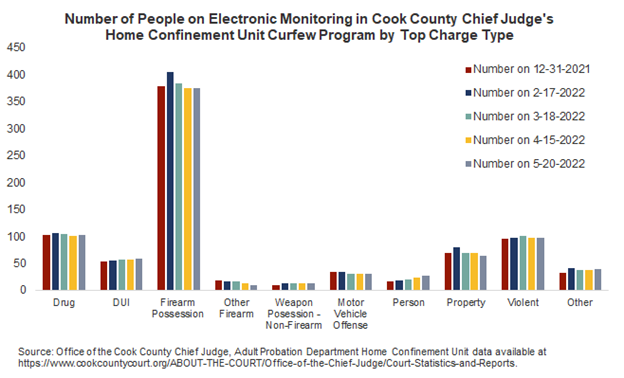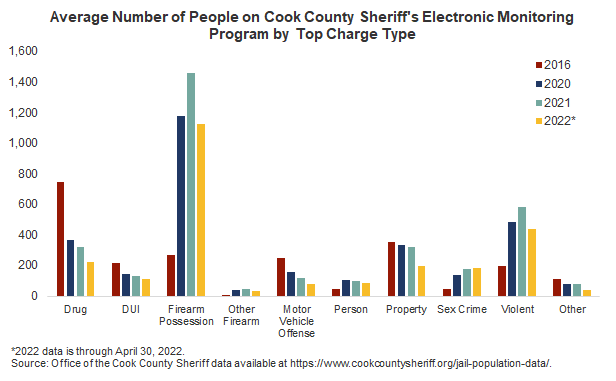June 03, 2022
With new data released by the Office of the Chief Judge of the Cook County Circuit Court earlier this year, a more complete understanding of the number of people confined to electronic monitoring, or home confinement, in Cook County—and the types of crimes they are charged with—is now available.
There are two main pretrial electronic monitoring programs in Cook County—one operated by the Cook County Sheriff and one operated by the Adult Probation Department within the Office of the Chief Judge. This structure is unusual, as most jurisdictions have one EM program run by the court. The Sheriff’s electronic monitoring program was created in 1989 to alleviate overcrowding at the Cook County Jail. A federal consent decree filed in 2010 (United States v. Cook County, Illinois, No. 10-2946) authorized the Sheriff to release non-violent defendants from the jail onto home electronic monitoring in order to reduce overcrowding at the jail, leading to a significant increase in the number of people on the electronic monitoring program. There are currently 2,279 people on the Sheriff’s electronic monitoring program. The Sheriff’s EM program requires people to remain in their home 24/7, with some exceptions that must be approved by Cook County Circuit Court.
The Chief Judge’s Adult Probation Department runs a separate curfew program through the Home Confinement Unit. This program monitors individuals using a radio frequency ankle device to monitor both pretrial defendants and individuals who have been convicted and are on probation or conditional release. Individuals in this program must be in their home from 7 p.m. until 7 a.m. There were 817 people ordered to the curfew program as of May 13. Approximately 85% of people in the Chief Judge’s curfew program are pretrial defendants according to the Circuit Court website.
The Office of the Chief Judge also runs a third GPS monitoring program to track the location of both pretrial defendants and probationers convicted of violating orders of protection in domestic violence cases. Based on the most recent data available from the Office of the Chief Judge, there were 837 individuals monitored through this program on May 13.
Regardless of the entity operating each program, judges determine which pretrial defendants are ordered to electronic monitoring. The Sheriff’s EM program handles the highest risk pretrial defendants, while the Chief Judge’s curfew program is used for lower risk defendants.
The chart below shows the composition of the Chief Judge’s Home Confinement Unit curfew program based on data available between December 31, 2021 and May 20, 2022 by type of charge. The majority of people ordered to this program—approximately 46%—are charged with firearm possession.[1] Drug charges account for the second most frequent types of charges, making up 12.5%, followed by violent charges at 11.8%.[2]

The next chart shows the composition of the Sheriff’s electronic monitoring program by type of charge based on this data set on the Sheriff’s website. The data compare the average number of people on the Sheriff’s EM program in 2016, 2020, 2021 and 2022 (through April 2022). The Sheriff’s electronic monitoring program is significantly larger than the Chief Judge’s curfew program. The average daily EM population increased from 2,233 in 2016 to 3,026 in 2020 and 3,330 in 2021. The average daily population through April 2022 is 2,502.

Similar to the Chief Judge’s curfew program, firearm possession is the most common top charge among those ordered to the Sheriff’s EM. However, there have been some shifts in the number of charges among those ordered to EM. The number of people on EM charged with firearm possession has increased significantly since 2016, while the number of people on EM with drug charges has decreased since 2016. The number of people charged with crimes classified as violent has also increased while other nonviolent charges have decreased. Because electronic monitoring is highly restrictive, it is considered appropriate in cases when an individual presents a high level of risk based on a pretrial risk assessment or would otherwise be ineligible for release. It is not considered to be appropriate or effective in low-level, nonviolent cases. Additionally, many judges in Cook County require pretrial defendants to post monetary bail in order to be released to home electronic monitoring.
Spending on Electronic Monitoring in Cook County
The Sheriff’s electronic monitoring program, run through the Sheriff’s Community Corrections Department, is budgeted for an appropriation of $24.4 million in FY2022. This is approximately 4% of the Sheriff’s entire $631.5 million budget for the year. The Sheriff’s FY2022 electronic monitoring budget request increased by $4.9 million, or 25%, from the FY2021 appropriation. The increase was due to an increase in budgeted staff assigned to the electronic monitoring program from 134 full-time equivalent positions in FY2021 to 204 in FY2022 to handle an increase in the electronic monitoring population related to the COVID-19 pandemic and to implement a new case management model.
The Chief Judge’s Home Confinement Unit budget for FY2022 is $11.1 million, unchanged from the prior year. The number of personnel decreased from 85 full-time equivalent positions in FY2021 to 72 in FY2022. The Home Confinement Unit budget composes 20.5% of the Adult Probation Department budget, and 4.6% of the Chief Judge’s total $294 million budget.
Related Links:
What the Data Tell us about Bail Reform and Crime in Cook County
Cook County Seeks Consulting Services to Review Electronic Monitoring Practices
Chicago Appleseed Center for Fair Courts: Report: 10 Facts about Pretrial Electronic Monitoring in Cook County
[1] The most common firearm possession charge within this data set is aggravated unlawful use of a weapon, which means that a person carried or possessed a gun illegally (this does not include instances when a person pointed or discharged the firearm). There are numerous factors which constitute illegal gun possession laid out in Illinois statute: 720 ILCS 5/24-1.6.
[2] The most common violent charge within this data set is aggravated battery. There are numerous factors which constitute an aggravated battery, with and without the use of a firearm, laid out in Illinois statute: 720 ILCS 5/12-3.05.
